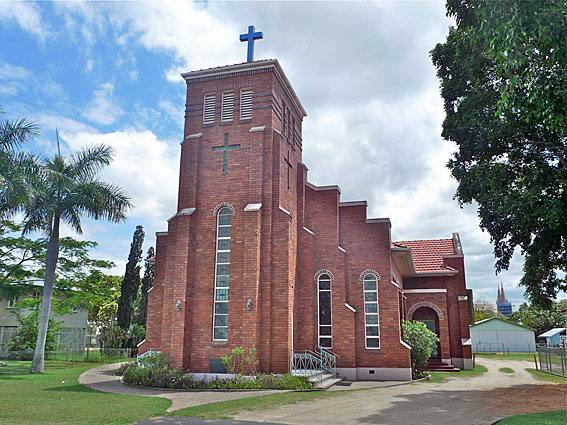
Campbell-Street Uniting (formerly Methodist) Church, Rockhampton
[Photograph by Trevor Bunning (November 2010)]

Campbell-Street Uniting (formerly Methodist) Church, Rockhampton
[Photograph by Trevor Bunning (November 2010)]
Historical and Technical Documentation by Geoffrey Cox
© OHTA 2011, 2013 (last updated May 2013)
The first Wesleyan services in Rockhampton were conducted in 1864, and the first church opened in Kent Street in August that year. The Kent Street building served as a place of worship until July 1881, when the first Campbell Street church was opened.1 The organist from 1895 until c.1944 was Mr N.G. Wiley, who was succeeded by his wife, Mrs N.G. Wiley, until 1970.2
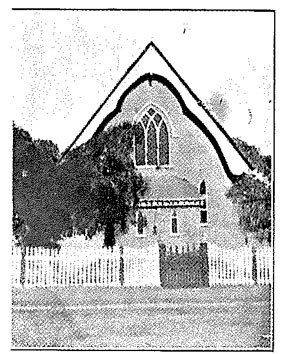
First Campbell Street Methodist Church
[Photograph from Campbell Street Circuit: A Century of Witness (1964)]
The pipe organ, originally located in the old church, was built in 1913 by B.B. Whitehouse & Co. of Brisbane at a cost of £457.3 An organ fund had been established by the middle of 1912,4 and a full description of the organ appeared in the local press at the time it was being installed in 1913:
CAMPBELL-STREET CHURCH.
NEW PIPE ORGAN.It is some time since a new pipe organ has been installed in Rockhampton, and for this reason the one that is being erected in the Campbell-street Methodist Church will no doubt be of considerable interest. The organ has been built by Messrs. B. B. Whitehouse and Co., of Brisbane, whose representative, Mr. J. H. Whitehouse, arrived in Rockhampton on Thursday last to superintend the erection of the instrument. Messrs. Whitehouse and Co. are noted for the excellent quality of their work, and to all appearances this instrument, as it lies unpacked, is of the very best workmanship. Considerable alterations have had to be made to the church to accommodate the organ. A recess, in the shape of a dome, has been let into the wall behind the pulpit, to a height of 17ft. 6in., with a width of 11ft. The pulpit will therefore he brought further forward, and the choir gallery will be built up on either side. The organ measures 15 ft. in height, 8 ft. 10-1/2in. in width, and 9 ft. 6 in. in depth. The specification is as follows : -
GREAT
1 Open Diapason
2 Dulciana
3 Flute
SWELL
4 Open Diapason
5 Lieblich Gedackt
6 Salicional
7 Oboe
PEDAL
8 Bourdon
COUPLERS
Swell to great.
Swell super to great.
Swell sub to great.
Great octave.
Swell to pedals.
Great to pedals.
8 ft.
8 ft.
4 ft.
8 ft.
8 ft.
8 ft.
8 ft.
16 ft.
(58 pipes) metal.
(58 pipes) metal.
(58 pipes) wood.
(46 pipes) metal.
(58 pipes) metal.
(46 pipes) metal.
(58 pipes) metal.
(30 pipes) wood.
Tremulant.
Balanced swell pedal.
The action is tubular pneumatic throughout, and the pipes are on 3 in. wind pressure. The stop keys are of the latest pattern, which simply require a light touch downward or upward to bring the stops on or off respectively. The soundboard is built upon the latest improved system, and there is a separate pallet for each note. Queensland timber has been used almost entirely in the construction, and the organ has been built specially to suit the climate. Extra precautions have been taken to prevent the intrusion of mice, &c., that might damage the delicate portions of the mechanism. The face of the organ will have a silvered pipe front, whilst the woodwork will be wax-finished.
The organ is to be blown by a Ross valve water engine, which will he installed in a separate recess outside the walls of the church proper, so that, should there be any noise from the engine, it will be inaudible in the church.
The total cost of the organ, which will take about a fortnight to erect, is £457.
The enterprise of the church in procuring such an excellent organ will no doubt meet with the reward it deserves. The instrument ought to be sufficiently varied and powerful for all the requirements of the church services.5
The instrument was opened on Saturday 29 November 1913 with a concert at which Mr F. Crawford, the organist of St Paul's Cathedral, Rockhampton, provided most of the organ solos:
The opening concert of the new pipe organ that has just been erected in the Campbell-street Methodist Church took place on Saturday evening and attracted a large audience, the building being quite full, and the proceedings all through wore most hearty and enthusiastic. The instrument is placed fairly high and stands well out as a background behind the pulpit. It improves the appearance of the church considerably, and will no doubt add very materially to the effectiveness of the praise services of the church. The proceedings opened with the singing of "Praise my soul the king of heaven," after which the following well-arranged programme was successfully carried out: - Organ, "Grand Choeur" (Salome), Mr. F. Crawford; solo, "Come unto Me" (Coenen), Mr. J. F. Walcot; organ "Humoreske" (Dvorak), Mr. N. G. Wiley; anthem, "Gloria" (Mozart), choir; organ, (a) Postlude in D (E. H. Smith) and (b) "Quies" (A. Freeman), Mr. F. Crawford; solo, "Nearer my God to Thee" (Carey) Miss L Jenkins; organ, Fugue in D (Bach), Mr. F. Crawford; anthem, "Sun of my soul " (Crook), choir; solo, "There is a Green-Hill" (Gounod), Mrs. W. F. Hurlson; organ, Largo in G (Handel), Mr F. Crawford; anthem, "Te Deum" (Jackson), choir and congregation; organ, Offertoire No. 4 (Lefebure-Wely).
Mr F. Crawford, the organist of St. Paul's Cathedral, handled the new instrument in a masterful manner, and the numbers he selected for performance were such as to display the stop combinations of the organ to full advantage. His first and last numbers particularly called for all the resources of the organ and all the registration it is capable of. The Bach Fugue gave the pedals full play, and in this the pedal tones were very good. The excellent coupler system in the organ adds materially to the volume, and this will be found particularly useful in accompanying congregational singing. The oboe, which is always a popular solo stop, stood out well in some of the solo parts, and with the tremulant, which in this organ is well pronounced, added greatly to the beauty of some of the works given. The pedal tone, uncoupled, is clear and round, making an effective soft support for solo work; and when coupled on to the full organ it rolls round the building in a dignified and majestic manner. The flute on the swell is also a pretty solo slop and capable of effective work. The dulciana is nicely voiced to balance solo work on the swell; whilst for very soft work the salicional and lieblich are all that could be desired. The volume of tone from the organ is quite sufficient for the size of the building, and the variations of tone, of which the organ is capable were well brought out on Saturday night. Needless to say, Mr. Crawford did the organ full justice, and his numbers listened to with keen appreciation.6
This was one of the firm's earliest pneumatic-action organs. It was driven originally by a hydraulic motor,7 but an electric blower was supplied in 1925. There were minor overhauls by Whitehouse Bros in September 1932, May 1938 and August 1949.8 The original specification, as given above, is confirmed in later accounts, although Bernie Brohan recorded that there was a hitch-down lever swell pedal. The console was originally attached.9
With the opening of the new Campbell-street church in 1959, the organ was rebuilt and installed in the new building by Whitehouse Bros of Brisbane. The action was electrified at this time, and the specification was enlarged by the addition of three stops (Gt. Principal 4ft; Sw. Cornopean 8ft; Ped. Bass Flute 8ft). The console was detached and placed below the pulpit.
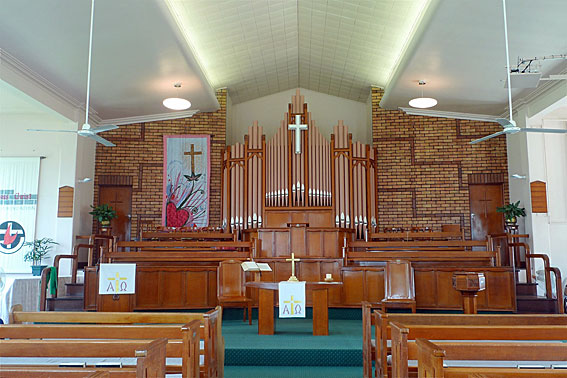

The enlarged organ in the 1959 Campbell Street church
[Photographs by Trevor Bunning (November 2010)]
In 1985, David Hudd further added the Great Fifteenth 2ft, transferred the Flute 4ft from the Great to the Swell, and removed the Swell Oboe 8ft. The manual compass, which had been increased to 61 notes, presumably in 1959, was restored to 58 notes by W.J. Simon Pierce in 1998 by the removal of off-chests.10
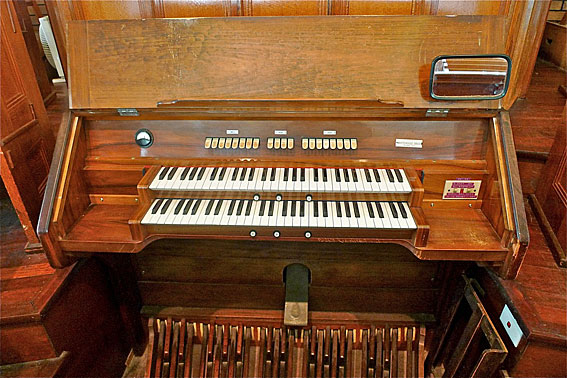
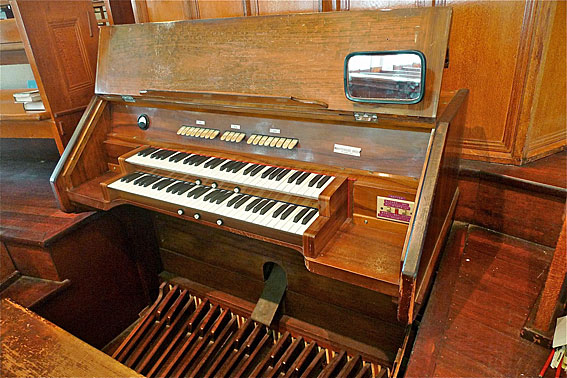
Console of the organ after reduction of the manual compass
[Photographs by Trevor Bunning (November 2010)]
| GREAT Open Diapason Dulciana Principal Fifteenth SWELL Diapason Salicional Gedact Flute Cornopean PEDAL Bourdon Bass Flute COUPLERS Great to Pedal Swell to Pedal Swell to Great Swell to Great Super Swell to Great Sub Swell Super Swell Sub Octave Swell Super Octave Great Octave |
8 8 4 2 8 8 8 4 8 16 8 |
|
[1959] [1985] [ex Great] [1959] [1959] |
Swell tremulant
Electro-pneumatic action
Detached stopkey console
Balanced swell pedal
3 thumb pistons to Great
3 thumb pistons to Swell
Compass: 58/30.11
______________________________________________________________________
1 Methodist Church of Australasia Queensland Conference, Campbell Street Circuit: A Centenary of Witness, 1864-1964 (printed by Oxford Press, Rockhampton, c.1964), pp. 3-5.
2 Campbell Street Circuit, op. cit., p. 6; personal communication from Mrs N. G. Wiley, June 1974.
3 Whitehouse Bros List gives 1912.
4 The Morning Bulletin (Rockhampton, 22 June 1912), p. 2.
5 The Morning Bulletin (Rockhampton, 15 November 1913), p. 5.
6 The Morning Bulletin (Rockhampton, 1 December 1913), p. 8.
7 Personal communication to G. Cox from Mrs N. G. Wiley, organist (1934-1970), June 1974.
8 Whitehouse Bros Ledger (1922-1940), p. 92, 271, 309; Whitehouse Bros Ledger (1940-1954), p. 269.
9 Original specification supplied to G. Cox by Mrs. N. G. Wiley (organist 1934-70), & from Collected Organ Specifications of Bernie Brohan (c.1952).
10 Personal communications to G. Cox from Mrs N. G. Wiley, June 1974, David Hudd, Sept. 1985, and W. J. Simon Pierce, c.1998.
11 Specification noted by G. Cox, July 1974, and Trevor Bunning, November 2010; Other details noted as above.
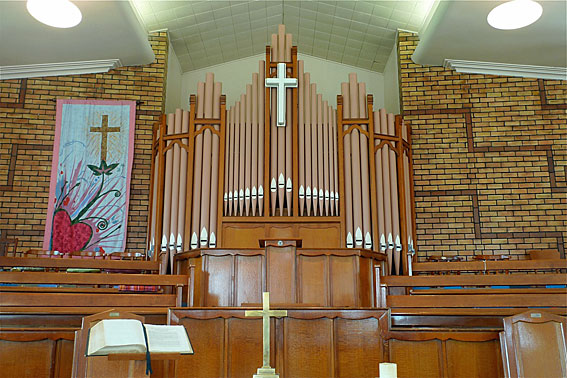
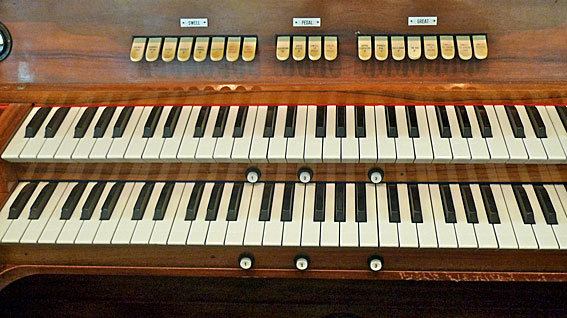
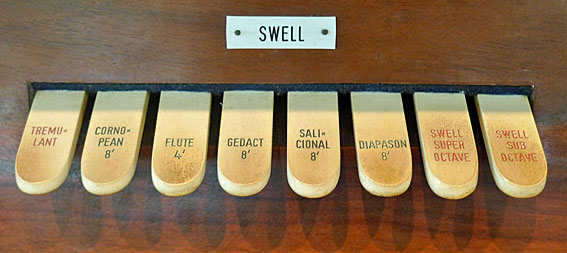
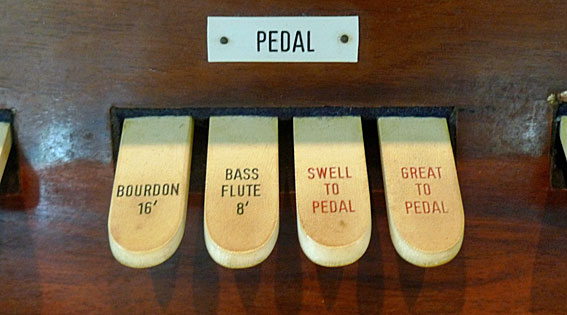
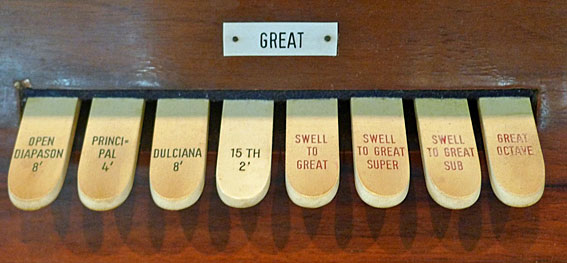
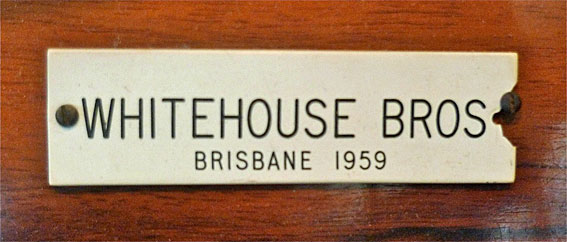
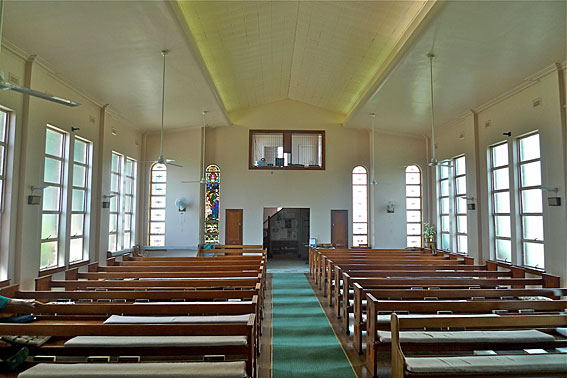
[Photographs by Trevor Bunning (November 2010)]